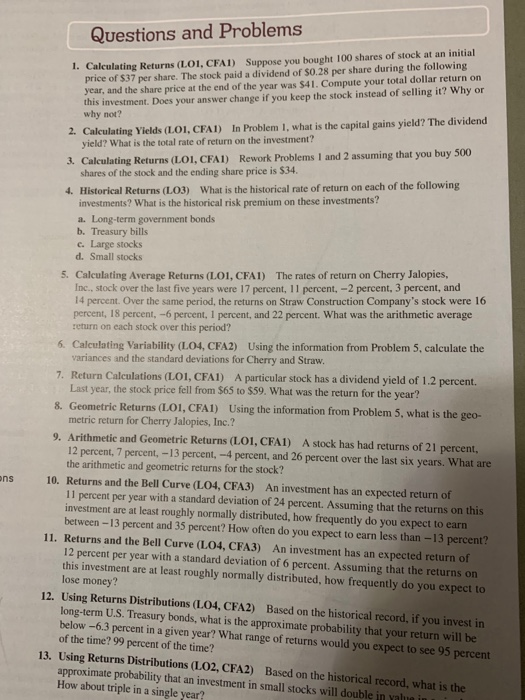Q9

Questions and Problems 1. Calculating Returns (LOI, CFAI) Suppose you bought 100 shares of stock at an initial price of $37 per share. The stock paid a dividend of $0.28 per share during the following year, and the share price at the end of the year was $41. Compute your total dollar return on this investment. Does your answer change if you keep the stock instead of selling it? Why or why not? 2. Calculating Yields (LOI, CFAI) In Problem I, what is the capital gains yield? The dividend yield? What is the total rate of return on the investment? 3. Calculating Returns (LOI, CFAD) Rework Problems 1 and 2 assuming that you buy 500 shares of the stock and the ending share price is $34. 4. Historical Returns (LO3) What is the historical rate of return on each of the following investments? What is the historical risk premium on these investments? a. Long-term government bonds b. Treasury bills c. Large stocks d. Small stocks 5. Calculating Average Returns (LOI, CFA1) The rates of return on Cherry Jalopies, Inc., stock over the last five years were 17 percent, 11 percent. -2 percent, 3 percent, and 14 percent. Over the same period, the returns on Straw Construction Company's stock were 16 percent, 18 percent, -6 percent, 1 percent, and 22 percent. What was the arithmetic average return on each stock over this period? 6. Calculating Variability (L04, CFA2) Using the information from Problem 5, calculate the variances and the standard deviations for Cherry and Straw. 7. Return Calculations (LOI, CFA) A particular stock has a dividend yield of 1.2 percent. Last year, the stock price fell from $65 to $59. What was the return for the year? 8. Geometric Returns (L.01, CFAI) Using the information from Problem 5. what is the geo- metric return for Cherry Jalopies, Inc.? 9. Arithmetic and Geometrie Returns (LOI, CFA1) A stock has had returns of 21 percent, 12 percent, 7 percent. -13 percent. -4 percent, and 26 percent over the last six years. What are the arithmetic and geometric returns for the stock? 10. Returns and the Bell Curve (L04, CFA3) An investment has an expected return of 11 percent per year with a standard deviation of 24 percent. Assuming that the returns on this investment are at least roughly normally distributed, how frequently do you expect to earn between - 13 percent and 35 percent? How often do you expect to earn less than - 13 percent? 11. Returns and the Bell Curve (L04, CFA3) An investment has an expected return of 12 percent per year with a standard deviation of 6 percent. Assuming that the returns on this investment are at least roughly normally distributed, how frequently do you expect to lose money? ons 12. Using Returns Distributions (L04, CFA2) Based on the historical record, if you invest in long-term U.S. Treasury bonds, what is the approximate probability that your return will be below -6.3 percent in a given year? What range of returns would you expect to see 95 percent of the time? 99 percent of the time? 13. Using Returns Distributions (LO2, CFA2) Based on the historical record, what is the approximate probability that an investment in small stocks will double in yalna i How about triple in a single year








